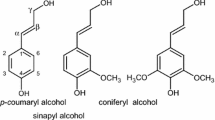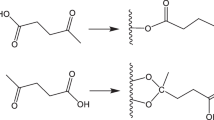Abstract
Formation of benzyl esters from acetic and formic acids during heat treatment of birch at 160–200°C has been studied by gas chromatography. High concentrations of formic and acetic acids formed by the wood itself during hydrothermal treatment were found. The concentrations of acids increased with both treatment time and temperature. The maximum formic- and acetic acid concentrations found at 180°C and after 4 h of treatment performed in this work were 1.1 and 7.2%, based on dry-weight wood, respectively. The treated wood material was characterised by mechanical testing [bending tests perpendicular to the grain, modulus of rupture, modulus of elasticity, Brinell hardness, impact bending and colour measurements (CIE colour space)]. The experiments, where high concentration of acids was formed, showed severe losses in mass and mechanical strength. Indications of possible enhanced mechanical properties for the treated, compared with untreated birch wood were found around 180–200°C at short treatment times. This paper discusses possible degradation reactions coupled with the colour and mechanical properties in relation to acid formation, and suggestions for process optimisations.





Similar content being viewed by others
References
Alén R, Lahtela M, Niemelä K, Sjöström E (1985) Formation of hydroxy carboxylic acids from softwood polysaccharides during alkaline pulping. Holzforschung 39:235–238
Bekhta P, Niemz P (2003) Effect of high temperature on the change in colour, dimensional stability and mechanical properties of spruce wood. Holzforschung 57:539–546
Bethge PO, Lindström K (1974) Determination of organic acids of low relative molecular mass (C1 to C4) in dilute aqueous solution. Analyst 99:137–142
Bourgois J, Guyonnet R (1988) Characterization and analysis of torrefied wood. Wood Sci Technol 22:143–155
Bourgois PJ, Janin G, Guyonnet R (1991) The color measurement: a fast method to study and to optimize the chemical transformations undergone in the thermically treated wood. Holzforschung 45:377–382
Dietrichs HH, Sinner M, Puls J (1978) Potential of steaming hardwoods and straw for feed and food production. Holzforschung 32:193–199
EN1534:2000 (2000) Wood and parquet flooring—determination of resistance to indentation (Brinell)
Feng Z, Alén R, Niemelä K (2002) Formation of aliphatic carboxylic acids during Soda-AQ pulping of Kenaf bark. Holzforschung 56:388–394
Fengel D, Wegener G (1989) Wood: chemistry, ultrastructure, reactions. Walter de Gruyter, New York, Berlin
Garrote G, Dominguez H, Parajó JC (2001) Study on the deacetylation of hemicelluloses during the hydrothermal processing of Eucalyptus wood. Holz Roh Werkst 59:53–59
Henriksson G (1995) Course material in wood chemistry. Royal Institute of Technology, Division of Forest Products Chemical Engineering, Stockholm, Sweden
Hodgkinson JM (2000) Flexure. In: Hodgkinson JM (ed) Mechanical testing of advanced fibre composites. Woodhead Publishing Limited, Cambridge, England, pp 124–142
Hon DN-S, Minemura N (1991) Color and discoloration. In: Hon DN-S, Shiraishi N (eds) Wood and cellulosic chemistry. Marcel Dekker, New York, pp 395–454
Jung B, Roffael E (2002) Über die Acidität einheimischer Holzarten. Holz Roh Werkst 60:154
Kamden DP, Pizzi A, Guyonnet R, Jermannaud A (1999) Durability of heat-treated wood. In: Proceedings: IRG WP: International research group on wood preservation 30, Rosenheim, Germany, 6–11 June, pp 1–15
Klauditz W, Stegman G (1947) Über die Grundlegenden Chemischen und Physikalischen Vorgänge bei der Wärmevergütung von Holzfaserplatten. Mitteilung zur Chemie, Physik, Biologie und Technologie des Holzes, Walter de Gruyter, Berlin 5:68–74
Kubojima Y, Okano T, Ohta M (2000) Bending strength and toughness of heat-treated wood. J Wood Sci 46:8–15
Lai Y-Z (1991) Chemical degradation. In: Hon DN-S, Shiraishi N (eds) Wood and cellulosic chemistry. Marcel Dekker, New York, pp 455–524
Li S, Lundqvist K, Westermark U (2000) Cleavage of syringylglycerol β-syringyl ethers during soda cooking. Nord Pulp Pap Res J 15:184–189
Manninen A-M, Pasanen P, Holopainen JK (2002) Comparing the VOC emissions between air-dried and heat-treated Scots pine wood. Atmos Environ (Elsevier Science Ltd) 36:1763–1768
McDonald AG, Gifford JS, Dare PH, Steward D (1999) Characterisation of the condensate generated from vacuum-drying of radiata pine wood. Holz Roh Werkst 57:251–258
Millitz H, Tjeerdsma BF (2000) Värmebehandling av trä med PLATO-processen (Heat treatment of wood using the PLATO-process). In: Proceedings of the Träskydd-, värmebehandlat trä-, egenskaper och användningsområden, Stockholm, Sweden, 21 November
Noack D (1969) Über die Heiβwasserbehandlung von Rotbuchenholz im temperaturbereich von 100°C bis 180°C. Holzforschung 21:118–124
Ponder GR, Richards GN (1995) A review of some recent studies on mechanisms of pyrolysis of polysaccharides. Biomass Bioenerg (Pergamon, Elsevier Science Ltd) 7:1–24
Rapp AO, Sailer M (2001) Oil-heat-treatment of wood—process and properties. Drvna Industrija 52:63–70
Rusche H (1973) Thermal degradation of wood at temperatures up to 200°C. Part 1: strength properties of dried wood after heat treatment. Holz Roh Werkst 31:273–281
Sandermann W, Augustin H (1963) Chemical investigations on the thermal decomposition of wood. Part I: stand of research. Holz Roh Werkst 21:256–265
Sivonen H, Maunu SL, Sundholm F, Jämsä S, Viitaniemi P (2002) Magnetic resonance studies of thermally modified wood. Holzforschung 56:648–654
SSPlast161351 —Bestämning av slagseghet enligt Charpy hos hårdplast (1986) 1–13 SIS—Standardiseringskommisionen i Sverige, Stockholm, Sweden
Sundqvist B (2002) Color response of Scots pine (Pinus sylvestris), Norway spruce (Picea abies) and birch (Betula pubescens) subjected to heat treatment in capillary phase. Holz Roh Werkst 60:106–114
Sundqvist B (2003) Värmebehandling av trä: från ett historiskt perspektiv till kommersiell produktion av idag (Heat treatment of wood: from a historical view to commercial production of today). Technical report 2003:02. Luleå University of Technology, Division of Wood Material Science, Skellefteå, Sweden (in Swedish)
Syrjänen T, Jämsä S, Viitaniemi P (2000) Heat treatment of wood in Finland—state of the art. In: Proceedings of the Träskydd-, värmebehandlat trä-, egenskaper och användningsområden, Stockholm, Sweden, 21 November
Theander O, Nelson DA (1988) Aqueous, high-temperature transformation of carbohydrates relative to utilization of biomass. In: Tipson RS, Horton D (eds) Advances in carbohydrate chemistry and biochemistry. Academic, Harcourt Brace Jovanovich Publishers, San Diego, pp 273–326
Tjeerdsma BF, Boonstra M, Millitz H (1998a) Thermal modification of non-durable wood species. 2. Improved wood properties of thermally treated wood. In: Proceedings of the international research group on wood preservation, Maastricht, The Netherlands, 14–19 June
Tjeerdsma BF, Boonstra M, Pizzi A, Tekely H, Millitz H (1998b) Characterisation of thermally modified wood: molecular reasons for wood performance improvement. Holz Roh Werkst 56:149–153
Vernois M (2000) Heat treatment of wood in France—state of the art. In: Proceedings of the Träskydd-, värmebehandlat trä-, egenskaper och användningsområden, Stockholm, Sweden, 21 November
Viitaniemi P (1997) Thermowood—modified wood for improved performance. Wood: the ecological material, 4th Eurowood symposium, Stockholm, Sweden, 22–23 September, pp. 67–70
Acknowledgements
The authors are grateful to SkeWood/VINNOVA, Svenskt Trä and Kempestiftelserna for financial support.
Author information
Authors and Affiliations
Corresponding author
Rights and permissions
About this article
Cite this article
Sundqvist, B., Karlsson, O. & Westermark, U. Determination of formic-acid and acetic acid concentrations formed during hydrothermal treatment of birch wood and its relation to colour, strength and hardness. Wood Sci Technol 40, 549–561 (2006). https://doi.org/10.1007/s00226-006-0071-z
Received:
Published:
Issue Date:
DOI: https://doi.org/10.1007/s00226-006-0071-z




